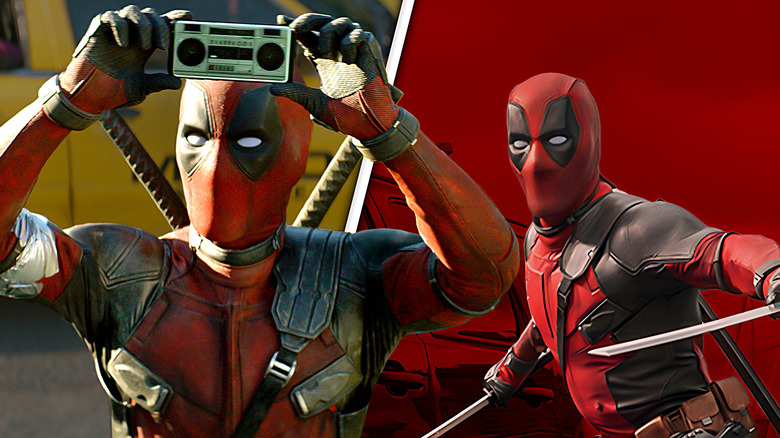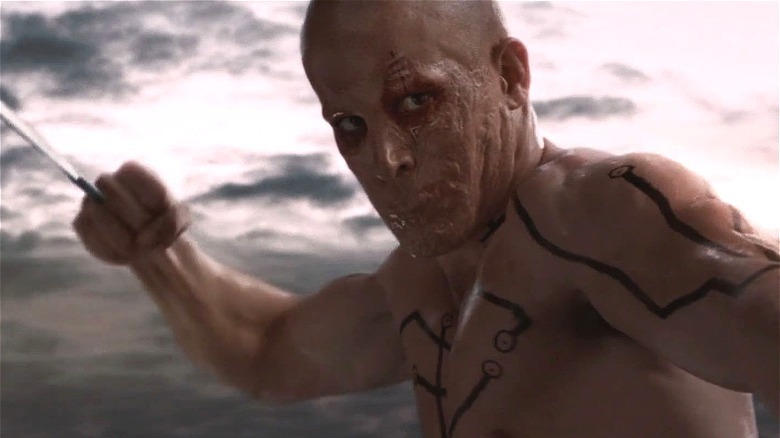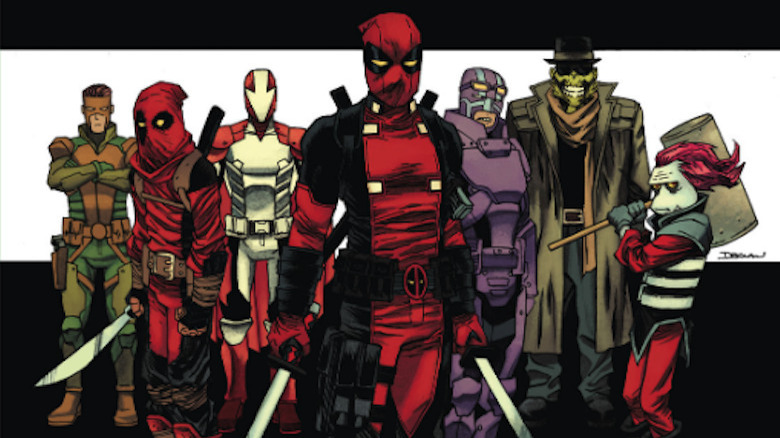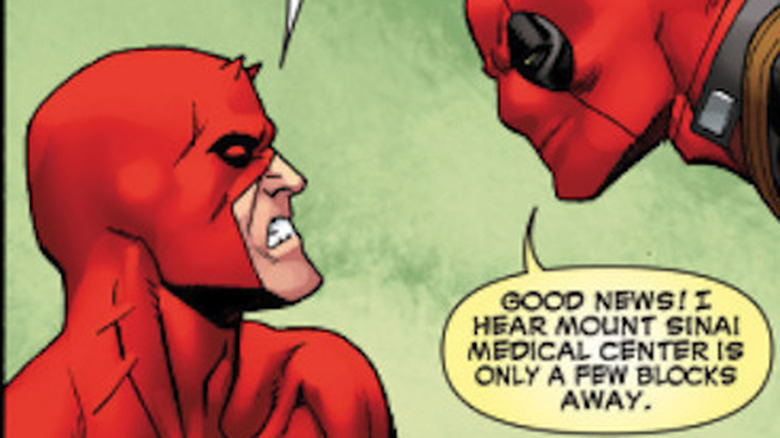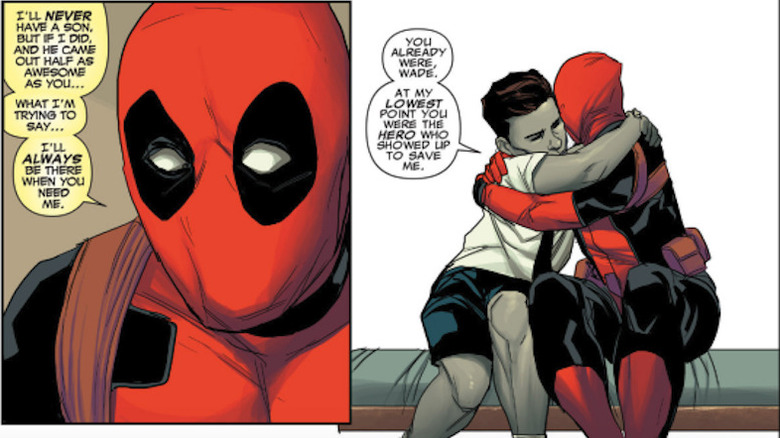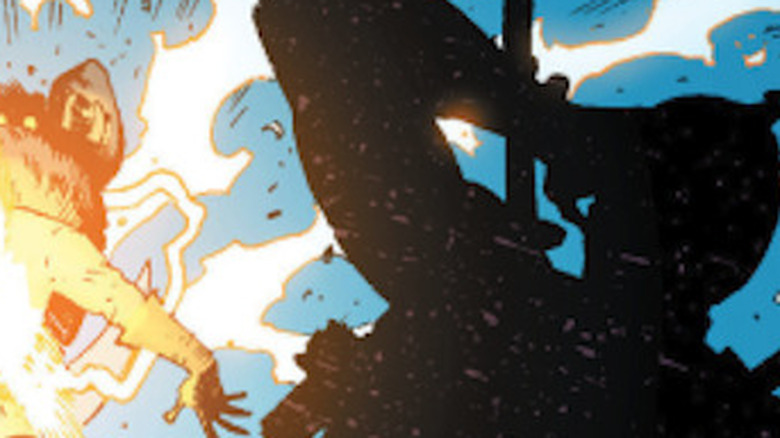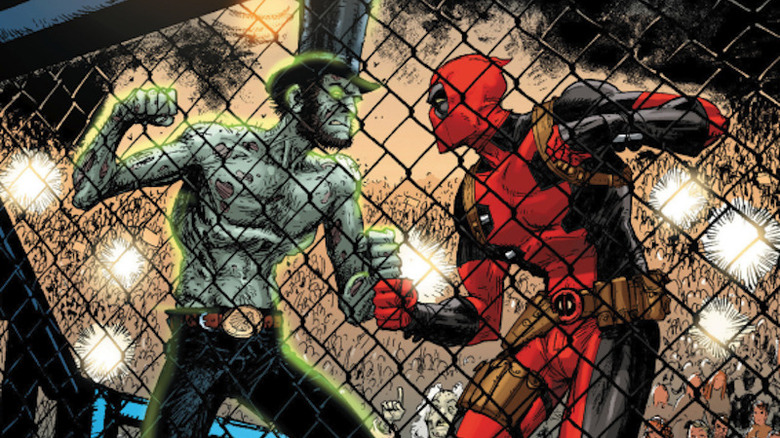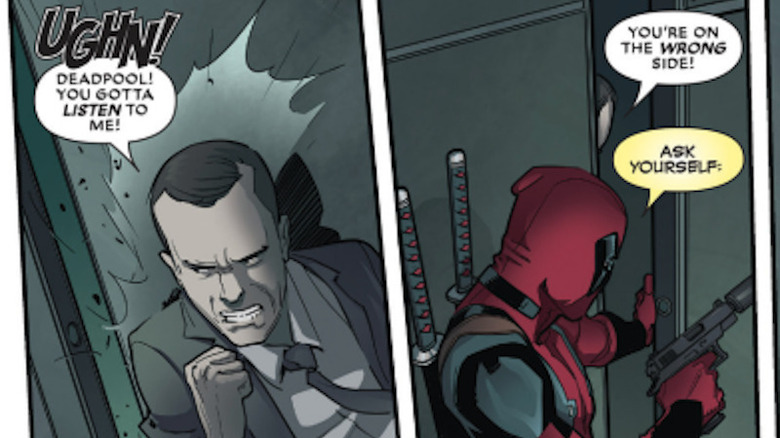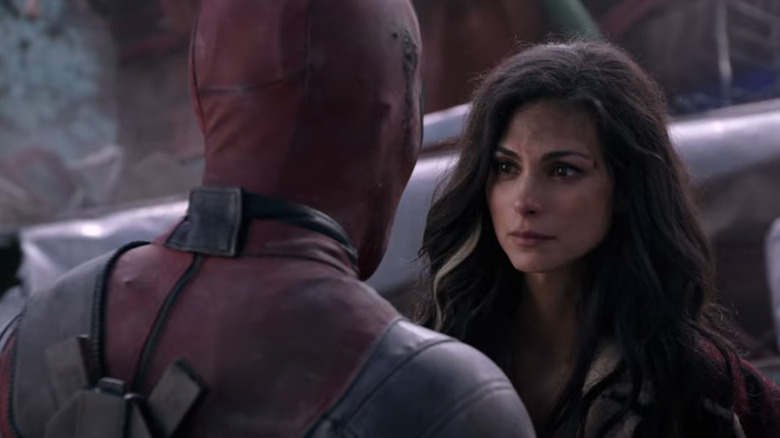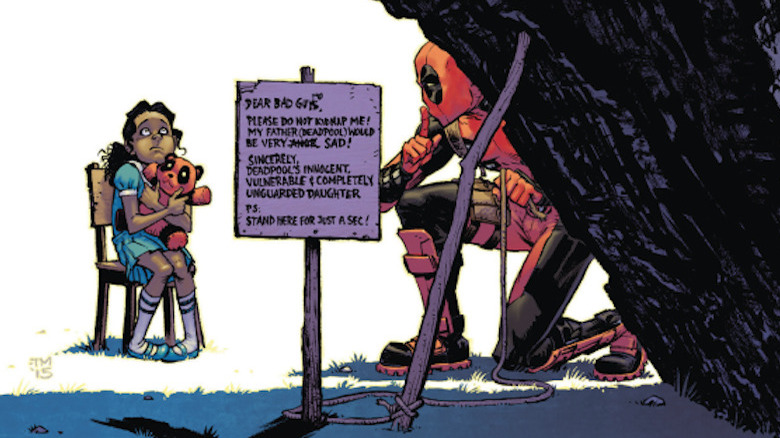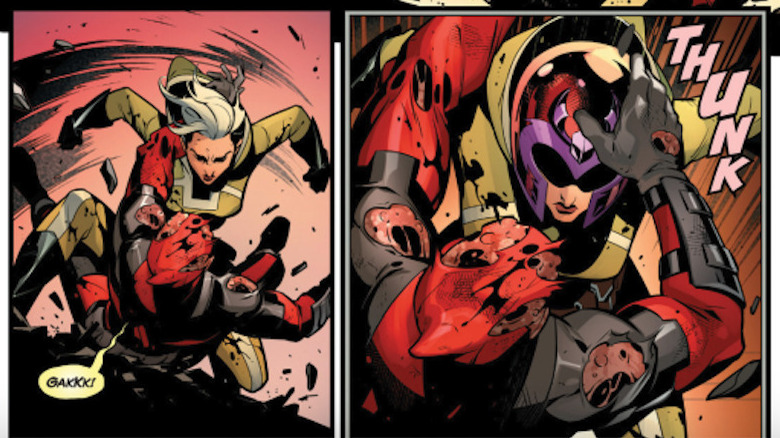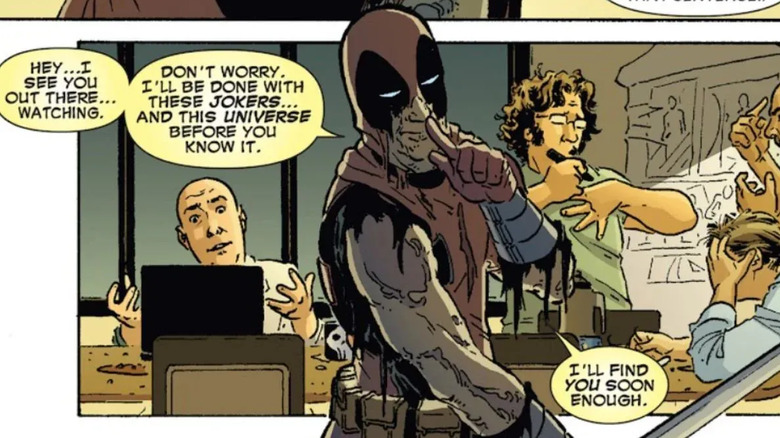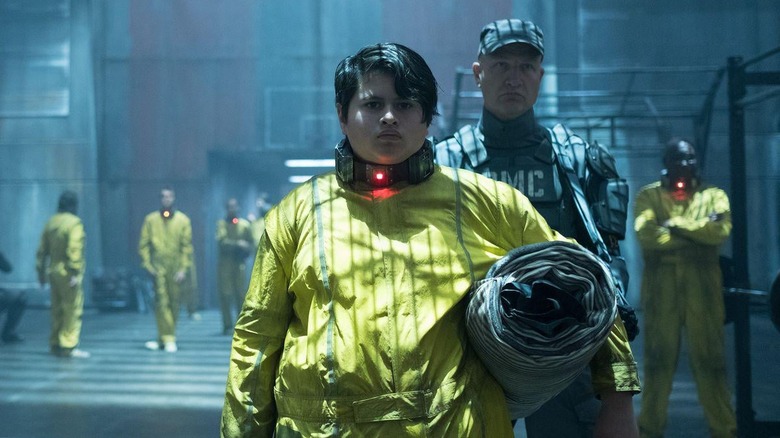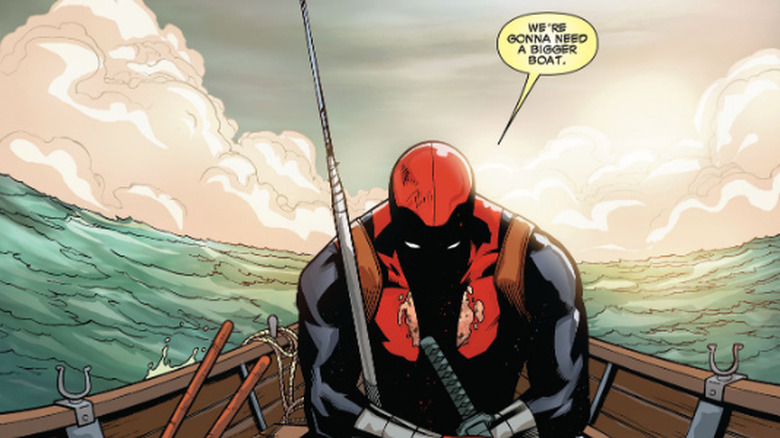6 Times Deadpool Was The Hero (And 7 He Was A Straight-Up Villain)
Deadpool, aka Wade Wilson, is a funny guy. In both comics and movies, he runs his mouth almost all the time, and a lot of what he has to say is hilarious. But don't let the motor mouth fool you. He's a superpowered guy, but he's not a hero in the traditional sense — and perhaps more often, he's a straight-up villain. In fact, the powers at work within him are constantly warring. He tries to be good — helping kids, giving his friends work, and saving the world from various baddies — but even when he's doing his best, he still ends up occasionally doing the wrong thing, such as setting an elephant on fire, shooting a random bystander, using his own daughter as bait, and killing all of Marvel's heroes and villains.
Deadpool is beloved because of his cracked — and often controversial — take on things but he's still an assassin who's willing to sell his services to the highest bidder. As a result, he's almost always willing to bend — or outright ignore — his moral compass if the situation calls for it. So while he's done some truly heroic things, he's also done some heinous, violent things. Ah, the duality of man.
Villain: Tried to kill Logan
There are three movies in the "Deadpool" trilogy starring Ryan Reynolds as Wade Wilson, but most people forget that he appeared in another movie as Deadpool: "X-Men Origins: Wolverine." In fact, Reynolds would probably prefer that we forget this outing as Deadpool. He voiced his displeasure with it in the end credits of "Deadpool 2" by killing this version of Deadpool — and then continuing to shoot him. But no matter what Reynolds does, his time as this version of Deadpool is still available to whoever wants to see it. And this version of Deadpool tried to kill Logan.
Deadpool was actually a rather minor part of "X-Men Origins: Wolverine," but in the third act, he was transformed into the ideal mutant by Stryker, the government suit who secretly wanted to control all mutants. Deadpool has the powers of 12 mutants in him ... and his mouth taken away. Then he's sent out to take down Wolverine. While he is controlled by Stryker, he is ultimately unsuccessful, but he still does a lot of damage. Thankfully, that version of Deadpool hasn't been seen since — outside of when he was shot in "Deadpool 2."
Hero: Gave Marvel D–listers work
Deadpool isn't exactly known for his altruistic ways, as seven things on this list can attest to. But in the "Deadpool & the Mercs for Money" arc in the comics, he forms a team of heroes most people have never heard of. In fact, these heroes are all Marvel D-listers, but despite not having a lot of time in the pages of Marvel comics, Deadpool decides they're all perfect.
The team, made up of Stingray, Solo, Foolkiller, Terror, Slapstick, and the new guy, Massacre — the Deadpool of Mexico — aren't household names, but Deadpool still attempts to make them (and himself) more popular ... by hiring them out to anyone who can pay. Sure, his motivations aren't entirely selfless, and the missions he sends them on aren't entirely on the up and up, but at least the Mercs for Money made sure these so-called heroes got some extra time in the spotlight, and that they could make rent. After all, these D-listers will take any help they can get.
Villain: Shot a random guy
The demon Vetis hires Deadpool to killing everyone who's ever gone to him for superpowers, a task Deadpool takes on with a surprising amount of gusto. While he's chasing down one victim in "Deadpool #11," though, Daredevil sets out to stop him. See, Daredevil thinks Deadpool is hallucinating the person he's tracking down, but while Deadpool may hallucinate sometimes, in this case, he's completely lucid. The result is a knock-down, drag-out fight that Daredevil ends up winning.
Daredevil hogties Deadpool and is going to take him to the authorities, a plan that will put a damper on Deadpool's ability to capture the man he's been sent for. So instead, Deadpool shoots a random bystander as a way to distract Daredevil so he can continue his chase. Daredevil ends up having to bring the guy to the hospital, and Deadpool gets away — and gets his man. Of course, while it's understandable that Deadpool needed a distraction, it's pretty awful that it came to putting bullets in random guys to make it happen.
Hero: Helped change Kid Apocalypse's destiny
Unlike its short-lived time in the movie "Deadpool 2," X-Force in the comics has a longer life. So when X-Force is dispatched to deal with a younger version of Apocalypse, the mutant who believes that only the strong survive, they kill him. But then the mutant Fantomex, feeling bad about killing him, takes some of the younger Apocalypse's blood and clones him. In the "Uncanny X-Force: Final Execution," when goons take this clone — known as Kid Apocalypse or Evan, depending on who you ask — to ensure he meets his fate as one of the worst mutant villains in the world, X-Force pursues, determined not to let Evan fall prey to them.
The main character who takes that on happens to be Deadpool. When they're in the bad guys' lair, he tells Evan he feels badly about killing his predecessor and does his best to protect him until others from X-Force can join them. Moreover, when Evan goes back to the Jean Grey School for Higher Learning, Deadpool sneaks into Evan's room and has a touching heart-to-heart with him where he tells him he'll always be there for him, seemingly sealing the deal that Evan will never go evil like Apocalypse.
Villain: Set an endangered elephant on fire
When a necromancer named Michael raises all the deceased presidents in U.S. history from the grave in "Deadpool Vol. 1 #2," part of the "Dead Presidents" arc, a zombified Teddy Roosevelt goes to the zoo and starts shooting animals. Roosevelt doesn't appear to know about zoos — or at least not to respect them — despite zoos being a new but growing aspect of American culture when he was president. (The first zoo opened in Philadelphia in 1874, and many zoos came to be in the 27 years between Philadelphia's opening and when Teddy was first elected president in 1901.) So when undead Roosevelt takes out a bear and threatens to shoot alpacas and camels, Deadpool is there to stop him.
Unfortunately, Deadpool's grand plan involves setting an endangered elephant on fire. Granted, the elephant first gored Deadpool, but it eventually got with the program and captured the former president. Deadpool asks the elephant to let Roosevelt go several times, but when it doesn't, he lights them both up. While Roosevelt deserved what Deadpool did, the elephant certainly did not. And it deserved the jokes Deadpool makes at its expense even less.
Hero: He stopped superpowered, undead presidents from destroying America
Despite Deadpool's actions toward the elephant in the "Dead Presidents" arc in "Deadpool Vol. 1 #1-6," he still manages to stop the undead presidents from destroying America, which is no small feat. The presidents decide it would be better to destroy the country and start over, and they do everything in their power to make it happen. Deadpool is the lone superhero — sorry, anti-hero — standing between us and total destruction because the people at S.H.I.E.L.D., his employer for this mission, want to keep the whole thing hush-hush.
So Deadpool not only takes down Teddy Roosevelt at the zoo, he also takes out Teddy's fifth cousin Franklin in New York's subway; tricks J.F.K. on the docks; goes up against some not-as-famous presidents like Polk and Tyler on San Francisco's Golden Gate Bridge as well as Harding and Hoover at the Hoover Dam; brawls with Lincoln in a boxing match in Las Vegas; goes to space to take on Reagan; and finally decapitates Washington in Washington, D.C. Considering all of this takes maximum effort, it's hard not to wonder why he does all this. Well, Deadpool is Canadian, so he doesn't really care about the presidents. But he does care about money, and the people at S.H.I.E.L.D. promised him a boatload of it if he could take them down.
Villain: Killed Phil Coulson
"Agents of S.H.I.E.L.D." had a seven-season run on TV — between that and his time in the Marvel Cinematic Universe, Phil Coulson, played by Clark Gregg, became a beloved character. In the comic books, though, he wasn't quite as lucky. Midway through the run of "Agents of S.H.I.E.L.D.," comic-Coulson's life came to an end at the hands of Deadpool in "Deadpool #31." Deadpool wasn't brainwashed or suffering from a psychotic break, he simply was following Captain America's orders. He idolizes Captain America so much that he doesn't question him, he simply does what he's asked.
So when Captain America tells Deadpool to kill Agent Coulson on sight for the good of the country, instead of probing further, Deadpool just goes ahead and does the dirty deed, shooting Coulson through the heart. What Deadpool didn't know is that Captain America had become an agent of H.Y.D.R.A., a lesson everyone would soon learn in the extremely controversial "Secret Empire."
Hero: Saved Vanessa
In the "Deadpool" movies, Wade Wilson (Ryan Reynolds) is decidedly more PC than in the comics. Don't misunderstand; he's still a miscreant, and his movies get R-ratings, but he's not nearly as morally compromised. A lot of this is because of Vanessa (Morena Baccarin), his girlfriend and the love of his life. So although he lets her think he's dead when he goes to get the cancer treatment that turns him into Deadpool, he never stops caring for her. So much so that when Ajax (Ed Skrein) wants to hurt him, he takes Vanessa and holds her hostage.
Needless to say, Deadpool goes after Ajax and the pair fight, but when the helicarrier they're fighting on top of starts to collapse, Deadpool forgets about Ajax and goes to save Vanessa. He even manages to do it, putting her in the airtight chamber that was used to torture him and sending her flying over the side of the helicarrier into the scrapyard below. Of course, Vanessa may be the only person he'd do this for, but still, he saves her life, and even ends up reconciling with her too.
Villain: Used his young daughter as bait
Deadpool is unhappy when he finds out that Madcap has been dressing up as him and framing him for murder, so in "Deadpool #5," to draw him out he decides to do something novel: Use his own daughter as bait. The thing is that Deadpool barely knows Ellie, having abandoned her mother before she was born, and has only recently been introduced to her. So Ellie is understandably angry with him when he comes to see her. Of course, she goes from angry to scared when he forces her to act as bait for Madcap.
This isn't the best example of parenting, especially when Deadpool is trying to get to know his daughter for the first time. Ultimately, though, Quicksilver saves her from an awful fate, and Ellie's too young to feel bad about the situation — in fact, to hear her tell it, it was a fun father-daughter outing. Moreover, Deadpool has a duel with Madcap, so he kind of got what he wanted without inflicting too much damage on Ellie. That's what Deadpool would call a win!
Hero: Helped save the world from Red Skull
In "The Uncanny Avengers: Red Skull," the Avengers are reeling from the revelation that Red Skull has gained Charles Xavier's powers by putting Xavier's brain in his head. But the Avengers quickly lose control of the situation when they realize that having Xavier's powers means Red Skull can control the minds of almost anyone — including pretty much the entire Avengers roster. The exception, of course, is Deadpool, whose mind is too fractured for such treatment. So when Deadpool enters Avengers Mansion, where the malevolent villain is holed up, Red Skull is surprised when Deadpool doesn't immediately fall prey to his telepathic control.
Of course, Red Skull's surprise doesn't last long, as Rogue, who is under Red Skull's mind control, quickly attacks Deadpool. It turns out, though, that this is all part of Deadpool's plan, because Rogue beating him allows Deadpool to get close enough to get Xavier's helmet, which blocks telepathic powers, out of his bag and on her head. While it's just the first step, with Rogue's mind now clear, Rogue is able to regain control and ultimately defeat Red Skull.
Villain: Killed the Marvel Universe
Deadpool has done a lot of questionable things in his time, but one of the worst has to be when he murders every hero and villain in Marvel comics in "Deadpool Kills the Marvel Universe." The trouble starts when the X-Men commit him to Ravenscroft Asylum, under the impression that Deadpool's problems were too great for them to handle. While there, Dr. Brighton, otherwise known as Psycho Man, tries to get Deadpool to do his bidding. He's unsuccessful but Psycho Man does instill the desire to get rid of every single superpowered person on the planet, which Deadpool does with stunning efficiency.
He shoots Spiderman in the head, kills both the Fantastic Four and the Avengers, takes off the Hulk's head, and wears Beast as a coat while murdering Wolverine. All this because he realizes that their destiny is not their own, but that of the people controlling them: the comic book writers. That's right, Deadpool has realized that he and everyone else are living in a fictional world. To him, these are mercy killings, and by the end, he even threatens the readers of the comics with death. Of course, Marvel exists in a multiverse, so some universes are still safe, but this one's version of Deadpool has gone very dark indeed.
Hero: Defended a 14-year-old boy when he didn't have his powers
Deadpool isn't exactly ideal parental material. However, when he (Ryan Reynolds) and Vanessa (Morena Baccarin) decide to put a bun in her oven in "Deadpool 2," he seems genuinely excited. Of course, then Vanessa dies and all Deadpool's dreams are crushed, so when he's put in the Icebox, a prison for mutants, with 14-year-old Russell Collins (Julian Dennison) aka Firefist, he doesn't exactly bond with the boy. Besides, with the collars they put around each mutant's neck dampening Wade's powers, he's more focused on trying to avoid dying from cancer.
That is, until Cable (Josh Brolin) breaks into the prison and starts taking shots at him and Russell. At first, Deadpool wonders what he did to tick Cable off, but when it becomes clear he's hunting Russell, not him, he immediately jumps into action on the boy's behalf, stopping Cable from shooting Russell and coming after him in his cell. Of course, this leads to the collar coming off and Deadpool getting his powers back, but his initial decision was made to protect Russell — despite Deadpool's protests to the contrary.
Villain: Killed a lot of literary characters
After Deadpool kills the Marvel Universe, he's at a bit of a loose end. No matter how many worlds he goes to and how many heroes and villains he kills, there's always another Spider-Man or Wolverine or Captain America. But then, in "Deadpool: Classics Killustrated," the scientists he kidnapped and put to work on the problem have a brilliant solution: They hypothesize that the characters in literary classics, who make up the ideaverse, are the inspiration for Marvel's stories, so if Deadpool kills them, the heroes and villains of Marvel cease to exist.
He goes through a portal into the ideaverse and proceeds to kill all the classic characters he can find: Captain Ahab, Don Quixote and Sancho Panza, Tom Sawyer, Dracula and his three brides, all four of the Little Women, Scrooge from "A Christmas Carol," Dr. Frankenstein, the Three Musketeers, and so on and so forth. He even kills Mowgli and all the animals from Rudyard Kipling's "The Jungle Book." Ultimately, Deadpool falls into the abyss, satisfied that he's killed all ideas, and Sherlock Holmes, the man who formed a team to try to stop him, is left to try to remember each and every one of the stories he murdered.
